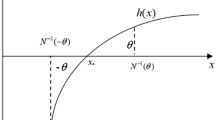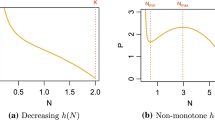Abstract
In this paper a Gause type model of interactions between predator and prey population is considered. We deal with the sufficient condition due to Kuang and Freedman in the generalized form including a kind of weight function. In a previous paper we proved that the existence of such weight function implies the uniqueness of limit cycle. In the present paper we give a new condition equivalent to the existence of a weight function (Theorem 4.4). As a consequence of our result, it is shown that some simple qualitative properties of the trophic function and the prey isocline ensure the uniqueness of limit cycle.
Similar content being viewed by others
References
Cheng K-S (1981) Uniqueness of a limit cycle for predator–prey system. SIAM J Math Anal 12: 541–548
Freedman HI (1980) Deterministic mathematical models in population ecology. Marcel Dekker, New York
Gause GF (1934) The struggle for existence. Williams and Wilkins, Baltimore
Gause GF, Smaragdova NP, Witt AA (1936) Further studies of interaction between predator and prey. J Animal Ecol 5: 1–18
Hasík K (2000) Uniqueness of limit cycle in the predator–prey system with symmetric prey isocline. Math Biosci 164: 203–215
Hasík K (2003) Uniqueness of limit cycle in predator–prey system: the role of weight functions. J Math Anal Appl 277: 130–141
Huang TW, Hsu SB (1995) Global stability for a class of predator–prey systems. SIAM J Math Anal 55: 763–783
Huang XC, Merrill S (1989) Condition for uniqueness of limit cycles in general predator–prey system. Math Biosci 96: 47–60
Kolmogorov AN (1936) Sulla teoria di Volterra della lotta per l’esistenza. Giorn Ist Ital Attuari 7: 74–80
Kolmogorov AN (1972) A qualitative study of mathematical models of population dynamics. Problemy Kibernet 25: 101–106 (in Russian)
Kuang Y (1988) Nonuniqueness of limit cycles of Gause-type predator–prey systems. Appl Anal 29: 269–287
Kuang Y (1990) Global stability of Gause-type predator–prey systems. J Math Biol 28: 463–474
Kuang Y, Freedman HI (1988) Uniqueness of limit cycles in Gause type models of predator–prey systems. Math Biosci 88: 67–84
Liou L-P, Cheng K-S (1988a) On the uniqueness of a limit cycle for a predator–prey system. SIAM J Math Anal 19: 867–878
Liou L-P, Cheng K-S (1988b) Global stability of a predator–prey system. J Math Biol 26: 65–71
Murray JD (1989) Mathematical biology. Springer, Berlin
Rosenzweig LM, MacArthur RH (1963) Graphical representation and stability conditions of predator–prey interactions. Am Nat 47: 209–223
Xiao D, Zhang Z (2003) On the uniqueness and nonexistence of limit cycles for predator–prey systems. Nonlinearity 16: 1185–1201
Author information
Authors and Affiliations
Corresponding author
Additional information
The research of this author was supported, in part, by projects 201/06/0318 from the Czech Science Foundation, and MSM4781305904 from the Czech Ministry of Education. Support of these institutions is gratefully acknowledged.
Rights and permissions
About this article
Cite this article
Hasík, K. On a predator–prey system of Gause type. J. Math. Biol. 60, 59–74 (2010). https://doi.org/10.1007/s00285-009-0257-8
Received:
Revised:
Published:
Issue Date:
DOI: https://doi.org/10.1007/s00285-009-0257-8




